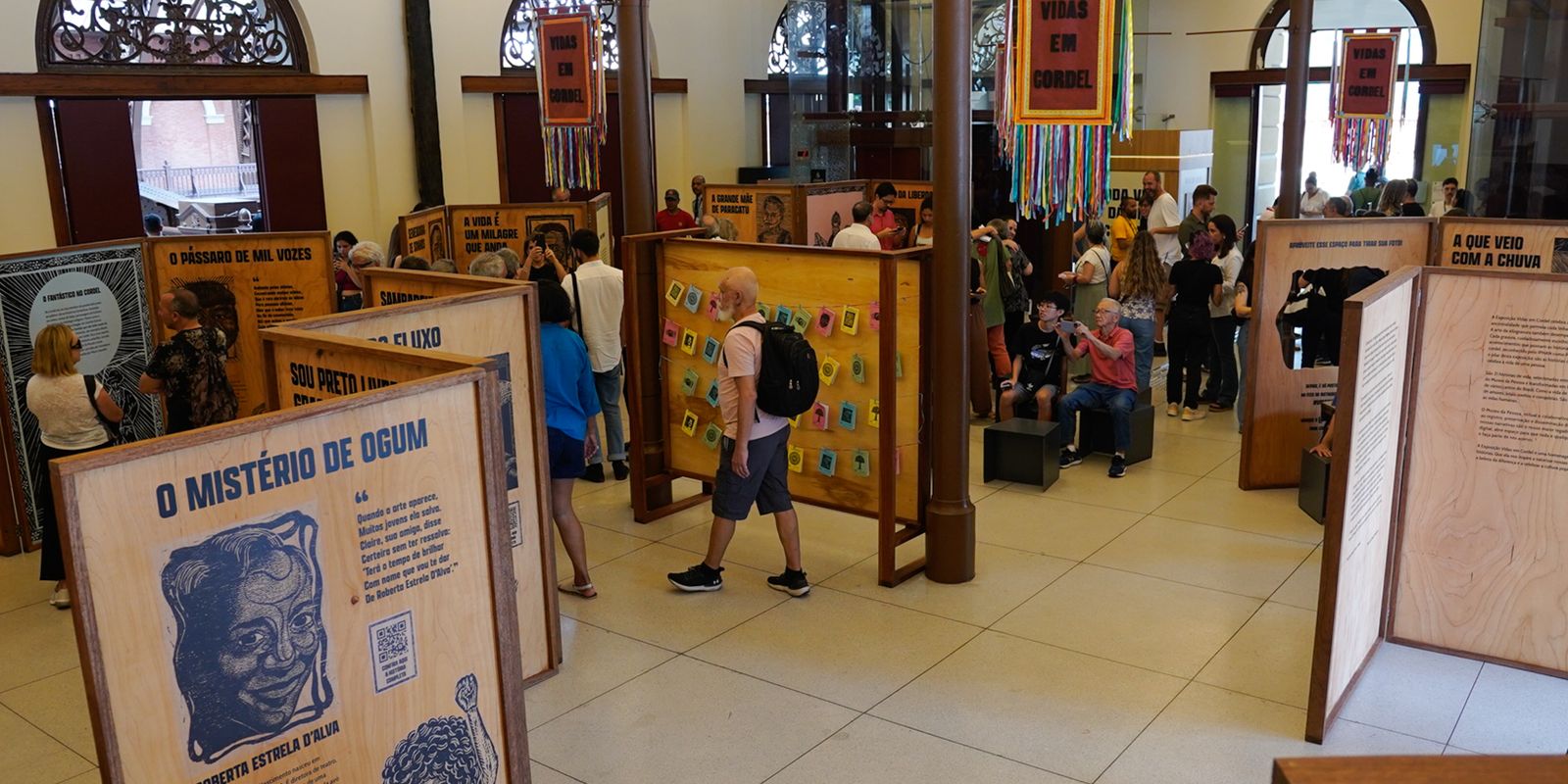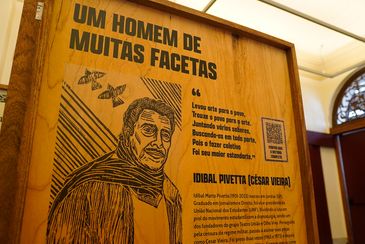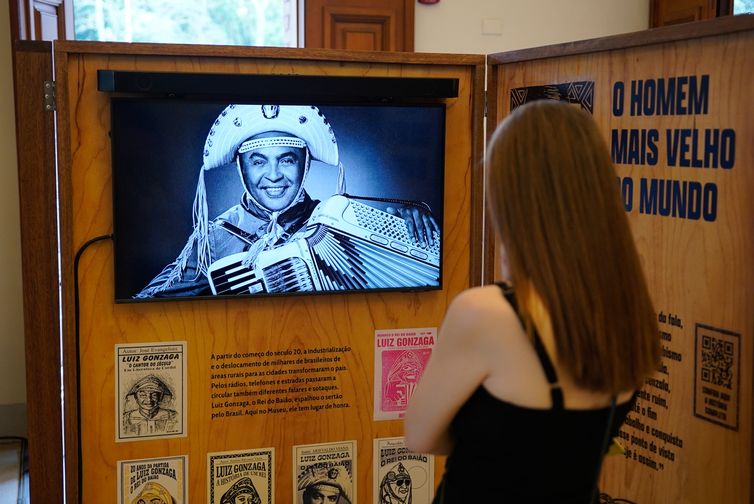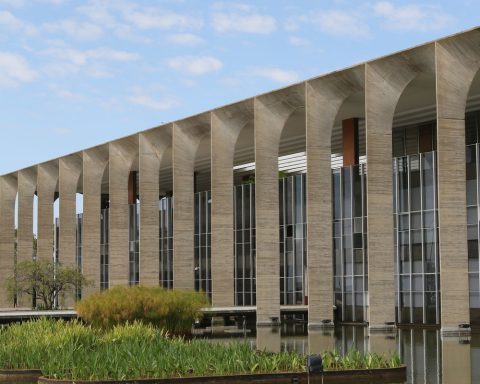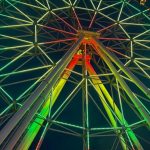The verse of the song Chico Preto, by composers João Nogueira and Paulo Cesar Pinheiro, already said: “your story will one day become a cordel”. And starting this Saturday (2), anyone who passes by the Portuguese Language Museum, in the Luz region, in the capital of São Paulo, will be able to come across an exhibition that tells the story of 21 people through cordel literature.
Call from Lives in Cordelthe exhibition celebrates oral tradition, popular poetry and ancestry and is carried out by the Portuguese Language Museum with the Museu da Pessoa, a virtual and collaborative space that has been dedicated, for 30 years, to recording, preserving and disseminating life stories . The curatorship is by the poet and cordelist Jonas Samaúma, the cordelist and researcher of Brazilian folklore Marco Haurélio, and the woodcut artist Lucélia Borges.
Among the personalities whose stories were highlighted and who are portrayed in the exhibition are the journalist Gilberto Dimenstein and the indigenous and immortal leader of the Brazilian Academy of Letters, Ailton Krenak. But there are also lesser-known names, of ordinary people, who also had relevant work for the country.
The exhibition arrives in São Paulo after passing through Pernambuco, Bahia and Minas Gerais. In São Paulo, she gained three new stories, from personalities who developed impactful work in the Luz region, where the Portuguese Language Museum is located.
Stories
One of these three personalities is César Vieira, pseudonym of Idibal Matto Pivetta (1931-2023), who, as a lawyer, played an important role in the defense of political prisoners during the military dictatorship in Brazil. He was also one of the founders of the Teatro Popular União e Olho Vivo group, a pioneer in the use of collective creation processes. Persecuted by the censorship of the military regime, he began to sign his plays as César Vieira.
“For me, he will always be an incredible human being: a person with a very big heart. Due to the country’s need, he saw that it was necessary to join other people to exchange experiences, learn and also be able to build a fairer country. He graduated in law and journalism and was also a playwright. He was the founder of Teatro Popular União e Olho Vivo, which is a group that has been exchanging experiences in the capital’s popular neighborhoods for 75 years”, explained his son, Lucas Cesar Pizzetta.
Cesinha, as he is better known for inheriting his father’s pseudonym, said that he was invited by the Museu da Pessoa and the Museu da Língua Portuguesa to tell this story. “I think this type of initiative that contributes to telling the story of Brazilian popular culture is fundamental. Especially today, when we live in a time of such great domination by foreign culture. We need to tell these stories in an aggregated way, relating these themes to understand the context of the country”, he said, in an interview with Brazil Agency.
The story of Cesinha’s father was inspired by the poet Maria Celma. The cordel, which can be collected free of charge at the exhibition or viewed through the websitebegins this story with the following verses: “Talk about Idibal Pivetta. It requires common sense and courage. Man of many facets. And a lot of baggage. It marked the history of people. As author and character.”
In the report, Maria Celma said that, to start researching Idibal, she began consulting his biography, watching interviews and reading many works published about him. “And then I fell in love with his achievements, with the person, with the human aspect, with his social aspects. In addition to being pleasurable, it was an enriching experience to write about him. This enriched me as a person, as a citizen, as a Brazilian”, she said.
In addition to Pivetta’s story, the other unpublished stories included in the exhibition were that of Cleone Santos, a Minas Gerais woman from Juiz de Fora who created the Coletivo Mulheres da Luz, which offers support and gives visibility to women in situations of prostitution; and rapper MC Kawex, who lived for 20 years in the so-called Cracolândia, being an active voice in the region.
“Bringing the exhibition to São Paulo opened a big door so that we could also bring the history of people who are here, say, in our neighborhood, in our territory”, said Camila Aderaldo, coordinator of the Reference Center at the Language Museum Portuguese. “We managed to bring together three names to compose this exhibition. Organizing and putting these people’s stories into literature is almost a way of making them still present. And that is very powerful,” he added.
For Karen Worcman, founder and curator of the Museu da Pessoa, the exhibition is a great celebration of the Portuguese language. Furthermore, it expands our concept of building the country’s memory. “The basic idea of the Museu da Pessoa is to make each person’s story become a museum object. The museum aims to promote change, a democratization of social memory, expanding the way we tell our history in society.”
All the stories being presented in this exhibition in São Paulo were included in the collection of the Museu da Pessoa. Including those that will be told by the public themselves.
Cabin
This exhibition is not just made up of stories presented on panels and strings that can be picked up free of charge at the museum. There is also an interactive booth, where visitors can record their own testimonials.
“The Museu da Pessoa, which is always collaborative, always brings a booth of life stories. Every life gives a string. Every life is part of a museum. So the person who comes has the possibility of recording their story and joining the museum’s collection – and for free”, said Karen Worcman.
All these testimonies from the public will later be part of the digital collection of the Museu da Pessoa .
Cordel
Cordel emerged at a time when there was no radio, internet or TV and few knew how to read. To learn the stories, people took to the streets to listen to popular artists who narrated, in verse form, the events of the region. Until cheap printing techniques emerged and these stories began to be reproduced in small books that spread throughout Europe.
When it arrived in Brazil, it gained its own language, with humor, criticism and covers illustrated with woodcuts, a technique that consists of carving high and low relief images into pieces of wood that will later receive layers of paint and be reproduced on paper, like a kind of stamp.
“Cordel literature, as a genre, as culture, as history, has enormous strength for all Brazilians. This exhibition project, in addition to being beautiful, is extremely important from a socio-cultural point of view. This project is really an action to safeguard cordel literature”, said cordelist Maria Celma.
Since 2018, cordel literature and its associated assets, such as woodcuts, have been recognized as Brazilian cultural and intangible heritage by the National Historical and Artistic Heritage Institute (Iphan).
Show
The exhibition is being presented in Lobby B of the museum and is free to enter. It will be on display until February of next year.
The stories on display can also be accessed virtually, through the website In this online content, the booklet Vidas em Cordel para Educadores is also available, a free educational material aimed at teachers and which can be used in educational activities.
